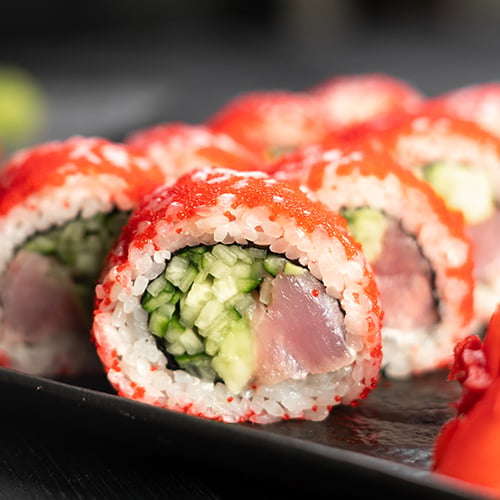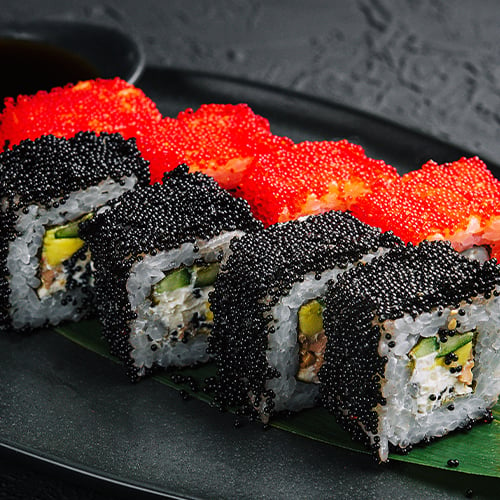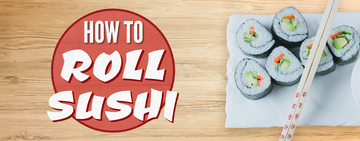Masago is a commonly used ingredient in Japanese cuisine, made from the eggs (fish roe) of the capelin fish. In Japanese, "masago'' translates to "fish eggs," and it is often used as a topping or garnish for sushi, sashimi, and other seafood dishes. Its vibrant color and delicate taste make it a popular choice for adding visual appeal and a burst of flavor to various culinary creations. Whether you are a sushi chef looking to enhance your creations or a restaurant owner seeking to expand your sushi supplies, masago is a versatile and flavorful ingredient that can add a unique touch to your dishes.
Masago Sushi

Masago roe is typically used as a topping or filling for sushi rolls. The small, orange-colored eggs add a burst of flavor and texture to the dish. Masago has a slightly salty taste and a delicate, crunchy texture, making it a perfect complement to the other ingredients in sushi. Below we’ve listed some of the most common types of sushi rolls masago is paired with:
- Masago California Roll - A classic sushi roll that combines the flavors of avocado, cucumber, and imitation crab. The addition of masago adds a burst of umami flavor and a satisfying crunch to each bite.
- Masago Spicy Tuna Roll - This roll is made with fresh tuna that has been mixed with spicy mayo and other seasonings. The mixture is then spread on a sheet of nori, rolled with sushi rice, and topped with masago.
- Masago Crunchy Shrimp Roll - A crunchy shrimp roll typically consists of tempura-battered shrimp, cucumber, and avocado. The roll is then topped with masago, adding a delightful texture contrast to the crispy shrimp and creamy avocado.
Masago vs Tobiko

When it comes to sushi and other Japanese dishes, two popular ingredients that often get confused are masago and tobiko. While they may appear similar, there are some key differences between the two that make each one unique:
- Origin - Masago comes from the capelin fish, which is found in the North Atlantic and North Pacific oceans. Tobiko, on the other hand, is the roe of flying fish, which is primarily harvested in Japan.
- Size and Texture - Masago is small in size and has a fine texture with a delicate, almost crunchy consistency. In contrast, tobiko has larger eggs and a slightly firmer texture.
- Color - Typically orange, masago is often used to add bright colors to enhance food presentation. Tobiko comes in a variety of colors, including orange, red, black, and green. These colors are often achieved through natural food dyes.
- Flavor - The flavor of masago is mild and slightly sweet, while also being briny. It adds a subtle burst of umami to dishes. Tobiko, on the other hand, has a more pronounced flavor and is often described as slightly salty with a hint of sweetness.
Masago vs Caviar
Unlike masago, caviar is fish roe that comes from sturgeon, a type of fish found mainly in the Caspian Sea. Another difference between the two is the size and texture. Masago is smaller in size and has a crunchy texture, while caviar is larger with a much softer texture. Caviar can also be commonly enjoyed on its own, while masago is typically reserved as a topping or garnish.
Masago vs Tamago
While both masago and tamago are used in Japanese cuisine, they are entirely different ingredients. Masago is fish roe, while tamago refers to a Japanese-style omelet. Tamago is made by mixing eggs with sugar, soy sauce, and mirin, and then cooking it in a rectangular pan to create a sweet and savory omelet. However, the two ingredients pair nicely together as the contrast between the salty masago and the sweet tamago makes for a delightful combination in sushi rolls.
Masago vs Ikura
Ikura comes from salmon, specifically the eggs of the salmon fish. It is known for its larger size and its distinct, intense flavor. Masago, on the other hand, is smaller in size, has a milder taste, and is often used just as a garnish. While both masago and ikura are commonly used as toppings for sushi rolls, ikura is often enjoyed on its own as a delicacy, or used to enhance the flavor of other dishes.
Masago Sauce
Masago sauce is typically made by mixing masago eggs with other ingredients such as soy sauce (or a soy sauce substitute), rice vinegar, sugar, and sometimes mayonnaise. The addition of these ingredients enhances the flavor profile of the sauce, balancing out the saltiness of the eggs and adding a touch of sweetness and acidity. Masago sauce has a unique texture, with the tiny eggs providing a pleasant pop and crunch when eaten. This sauce not only adds a delightful mouthfeel to dishes but also visually enhances the presentation with its vibrant orange color.
In Japanese cuisine, masago sauce is commonly used as a topping or filling for sushi rolls. Its salty and briny taste pairs well with the mild flavors of sushi rice and fresh seafood, such as tuna or salmon. It can also be used as a garnish for other seafood dishes and even salads, adding a pop of color and flavor.
Masago FAQ
Below, we answer some of the most common questions regarding masago:
What Does Masago Taste Like?

Masago has a unique taste that is often described as briny and salty. The small, crunchy eggs burst with flavor when you bite into them, infusing saltiness into any dish. The subtle taste of masago is often compared to that of caviar but with a milder and more delicate flavor. Masago’s small size and delicate texture make it an ideal topping for sushi rolls and sashimi, adding a pop of flavor and visual appeal without overpowering other ingredients.
What Fish Does Masago Come From?
Masago is most commonly sourced from the capelin fish, a small species found in the cold waters of the North Atlantic and North Pacific Oceans. Capelin are typically harvested during their spawning season, which occurs between late spring and early summer. Capelin are abundant in their home regions, making them ideal choices for masago production. These fish are carefully processed to extract the roe, which is then salted and flavored before being packaged for sale.
Is Masago Healthy?
Overall, masago can be a healthy addition to your diet when consumed in moderation. Its high protein content and omega-3 fatty acids make it a nutritious choice for certain diets. One area of concern with masago is the food’s high sodium content. Individuals who are watching their sodium intake should be mindful of the sodium content in masago and consume it in moderation.
How Long Does Masago Last?
To extend the shelf life of masago, it is essential to keep it refrigerated at all times, as keeping a consistent cooled temperature helps prevent rapid spoilage. Masago should also be stored in an airtight container to protect it from moisture and other contaminants. A commercial food storage container is recommended to ensure optimal freshness.
Masago is a versatile ingredient that adds both flavor and nutritional value to a variety of dishes. Learning how to properly incorporate this ingredient into your culinary repertoire can enhance the taste and visual appeal of your creations. Its small, orange-colored eggs add a burst of flavor and texture to sushi rolls, poke bowls, and other seafood dishes, taking them to the next level.



